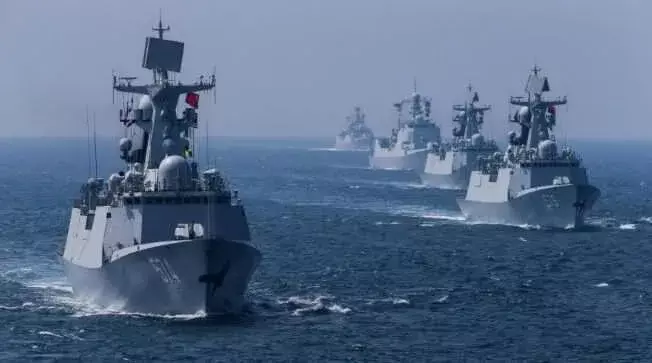China Proposes Ambitious Schemes For The “China-Indian Ocean Region”
For Beijing IOR is now CIOR

In opposition to the traditional practice of using the term “Indian Ocean” for the sea stretching from the Bay of Bengal to Antarctica over 9,600 km on the North-South axis, and from Southern Africa to Australia over 7,600 km on the East-West axis, China has begun using the term “China-Indian Ocean Region.”
The term “China-Indian Ocean Region” (CIOR) was used in many places in an official document relating to a recent international conference on the Blue Economy of the Indian Ocean Region (IOR).
The conference which was on “Boosting Sustainable Blue Economy to Build Together a Maritime Community with a Shared Future,” was held in Kunming, in the Yunnan Province of China on December 7 and 8.
According to a participant in the conference, the Chinese appeared to be against the identification of the Indian Ocean exclusively with India. Hence the re-designation of the IOR as “China-Indian Ocean Region” (CIOR) so that China too has a place in it.
Participants at the conference from the region appeared to endorse the Chinese view in this matter apparently because they too felt that the identification of the ocean with India alone gave the Indians a sense of ownership of the ocean and contributed to New Delhi’s bid to dominate it.
Both India and China are now competing for dominance over the Indian Ocean given its size and also its many hidden resources. The area covered by the Indian ocean is huge. The surface area is a whopping 70,560,000 sq km.
Political commentators in the IOR countries often refer with some trepidation to Sardar K.M.Panikkar’s seminal work “India and the Indian Ocean: an Essay on the Influence of Sea Power on Indian History” to substantiate their view that a powerful India would definitely want to dominate the Indian Ocean albeit essentially for its own security.
These IOR countries are therefore looking for a counterpoise to India’s ambitions and see emerging China as a candidate for that geopolitical role.
Though not an Indian Ocean Rim country, China has a deep interest in the Indian Ocean both to serve its current goals and to rekindle a historical interest. The mediaeval era Chinese Admiral Zheng He (1371–1433) had sailed round the Indian Ocean displaying China’s power. And now, with President Xi Jinping’s Belt and Road Initiative (BRI) in full swing, China is again surveying the Indian Ocean for both economic and political opportunities.
With India already having roots in the Indian Ocean, Beijing is coming up against New Delhi’s opposition. It is therefore launching many schemes to get a foothold in the IOR. It is in this context that Beijing is making a bid to rename the IOR as CIOR. Its proposals for jointly surveying, exploiting, and protecting the Indian Ocean give substance to this bid.
Here is a list of decisions taken at the CIOR conference in Kunming:
1. Establish a Disaster Prevention and Mitigation Cooperation Mechanism
2. Build a CIOR Think Tank Network that would be an open and shared academic platform and exchange mechanism.
3. Jointly conduct the measurement and compilation of a Blue Economy Index of the IOR.
4. Enhance the work of the China-Africa Cooperation Centre on Satellite Remote Sensing Application that was inaugurated in Beijing in July 2023.
5. Push forward the development of the China-Africa Marine Science and Blue Economy Cooperation Centre and carry out technical cooperation on marine survey, monitoring, forecasting and continental shelf research in Africa.
6. Jointly develop a big data analysis platform.
7. Carry out 200 “small yet smart” livelihood projects for countries in the Indian Ocean Region in the area of poverty reduction, agricultural development, medical and health care, culture and education, climate change response and green development.
8. Launch the Blue Talent Programme in which, in the next three years, China will endeavour to train 20,000 professionals in various fields for countries in the Indian Ocean Region, while carrying out 100 special training programmes covering green development, climate change response, ocean planning, development of fisheries etc.
9. Set up the China-Indian Ocean Region Maritime Cooperation and Training Centre which will encourage marine observation and forecasting, marine spatial planning, marine ecological protection and restoration.
10. Launch a Blue Citizen Initiative to improve countries’ governance capacity to ensure sustainable marine development.
11. Launch a climate information and early warning system in cooperation with the UN Development Programme (UNDP).
12. Implement Sustainable Fisheries Development in the countries in the region.
13. Create a New Energy Indian Ocean Initiative to promote photo-voltaic power generation, hydro-electric power generation, marine renewable energy and electric vehicles.
Thus, China is gearing itself to lead and foster cooperation aimed at developing the Blue Economy through the length and breadth of the vast Indian Ocean. And to legitimise its extraterritorial interest in an area that has traditionally acknowledged the centrality of India, China has re-designated the IOR as “China-Indian Ocean Region” (CIOR).



